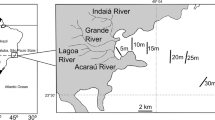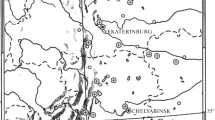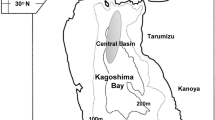Abstract
Size-frequency distributions from subtidal populations of Terebratella inconspicua (Sowerby, 1846) consistently display prominent modes at 18 to 22 mm shell length, representing many years accumulation of non-growing adults. In addition, these distributions contain seasonally variable modes made up of new recruits which are present in very high numbers towards the end of the breeding season, but are reduced to very low numbers by the end of their first year of life. Growth of recruits follows a sigmoid curve with considerable variability between individuals. Some adults survive at least 14 years. Females are 2 years old before they breed. Larvae are brooded internally by the parent and spawned in autumn and spring. The density of recruitment is positively correlated with the density of residents. Larvae commonly settle on the shells of large brachiopods; these recruits can survive to breed, but their survivorship as adults is lower than that of conspecifics attached to rock. Total mortality in the population is size (=age)-dependent; the mean life expectancy of a new recruit is 0.54 years compared with 2.57 years for a 1 year-old. Sources of mortality are considered.
Similar content being viewed by others
Literature Cited
Ayling, A.M.: The role of biological disturbance in determining the organisation of subtidal encrusting communities in temperate waters, 151 pp. Ph.D. thesis, University of Auckland, Auckland 1976
Boucot, A.J.: Life and death assemblages among fossils. Am. J. Sci. 251, 25–40 (1953)
Brookfield, M.E.: The life and death of Torquirhynchia inconstans (Brachiopoda, Upper Jurassic) in England. Palaeogeogr. Palaeoclim. Palaeoecol. 13, 241–259 (1973)
Doherty, P.J.: Aspects of the feeding ecology of the subtidal brachiopod, Terebratella inconspicua (Sowerby, 1846), 183 pp. M.Sc. thesis, University of Auckland, Auckland 1976
Fagerstrom, J.A.: Fossil communities in paleoecology: their recognition and significance. Bull. geol. Soc. Am. 75, 1197–1216 (1964)
Hyman, L.H.: The invertebrates. Vol. 5. Smaller coelomate groups, 783 pp. New York: McGraw-Hill 1959
Jackson, J.B.C.: Competition on marine hard substrata: the adaptive significance of solitary and colonial strategies. Am. Nat. 111, 743–767 (1977)
McKerrow, W.S., R.T. Johnson and M.E. Jakobson: Paleoecological studies in the Great Oolite at Kirklington, Oxfordshire. Palaeontology 12, 56–83 (1969)
Neall, V.E.: Notes on the ecology and paleoecology of Neothyris, an endemic New Zealand brachiopod. N.Z. Jl mar. Freshwat. Res. 4, 117–125 (1970)
Noble, J.P.A., A. Logan and G.R. Webb: The recent Terebratulina community in the rocky subtidal zone of the Bay of Fundy, Canada. Lethaia 9, 1–17 (1976)
Paine, R.T.: Filter-feeding pattern and local distribution of the brachiopod Discinisca strigata. Biol. Bull. mar. biol. Lab., Woods Hole 123, 597–604 (1962)
—: Ecology of the brachiopod Glottidia pyramidata. Ecol. Monogr. 33, 255–280 (1963)
—: Growth and size distribution of the brachiopod Terebratalia transversa Sowerby. Pacif. Sci. 23, 337–343 (1969)
Percival, E.: A contribution to the life history of the brachiopod Terebratella inconspicua (Sowerby). Trans. R. Soc. N.Z. 74, 1–23 (1944)
Richards, R.P. and R.K. Bambach: Population dynamics of some Paleozoic brachiopods and their paleoecological significance. J. Paleont. 49, 775–798 (1975)
Rickwood, A.E.: A contribution to the life history and biology of the brachiopod Pumilus antiquatus. Trans. R. Soc. N.Z. (Zool.) 10, 163–182 (1968)
—: Age, growth and shape of the intertidal brachiopod Waltonia inconspicua Sowerby, from New Zealand. Am. Zool. 17, 63–73 (1977)
Rudwick, M.J.S.: The growth and form of brachiopod shells. Geol. Mag. 96, 1–24 (1959)
—: Notes on the ecology of brachiopods in New Zealand. Trans. R. Soc. N.Z. (Zool.) 1, 327–335 (1962)
Stearns, S.C.: Life-history tactics: a review of the ideas. Q. Rev. Biol. 51, 3–47 (1976)
Surlyk, F.: Life habit, feeding mechanism and population structure of the Cretaceous brachiopod genus Aemula. Palaeogeogr. Palaeoclim. Palaeoecol. 15, 185–203 (1974)
Thayer, C.W.: Size-frequency and population structure of brachiopods. Palaeogeogr. Palaeoclim. Palaeoecol. 17 139–148 (1975)
—: Recruitment, growth and mortality of a living articulate brachiopod, with implications for the interpretation of survivorship curves. Paleobiology 3, 98–109 (1977)
Webb, G.R., A. Logan and J.P.A. Noble: Occurrence and significance of brooded larva in a Recent brachiopod, Bay of Fundy, Canada. J. Paleont. 50, 869–871 (1976)
West, R.R.: Life assemblage and substrate of Meekella striatocostata (Cox). J. Paleont. 51, 740–749 (1977)
Author information
Authors and Affiliations
Additional information
Communicated by G. F. Humphrey, Sydney
Rights and permissions
About this article
Cite this article
Doherty, P.J. A demographic study of a subtidal population of the New Zealand articulate brachiopod Terebratella inconspicua . Marine Biology 52, 331–342 (1979). https://doi.org/10.1007/BF00389074
Accepted:
Issue Date:
DOI: https://doi.org/10.1007/BF00389074




